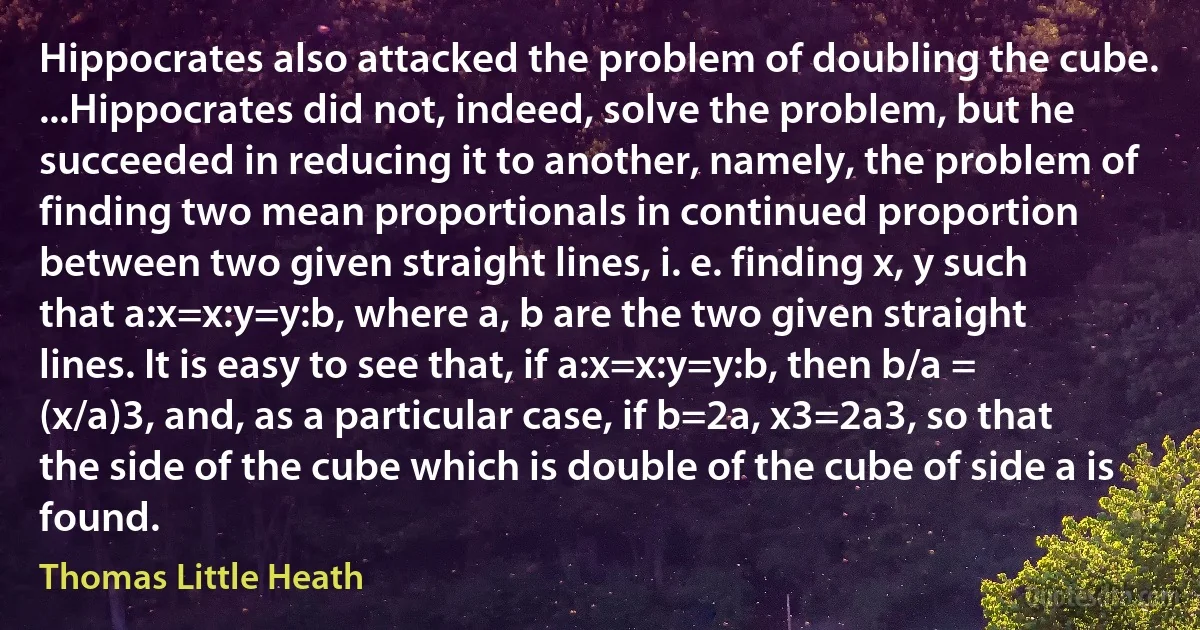
Hippocrates also attacked the problem of doubling the cube. ...Hippocrates did not, indeed, solve the problem, but he succeeded in reducing it to another, namely, the problem of finding two mean proportionals in continued proportion between two given straight lines, i. e. finding x, y such that a:x=x:y=y:b, where a, b are the two given straight lines. It is easy to see that, if a:x=x:y=y:b, then b/a = (x/a)3, and, as a particular case, if b=2a, x3=2a3, so that the side of the cube which is double of the cube of side a is found.
Thomas Little HeathRelated topics
case cube double doubling easy found given hippocrates mean problem reducing see side straightRelated quotes
If every day a man takes orders in silence from an incompetent superior, if every day he solemnly performs ritual acts which he privately finds ridiculous, if he unhesitatingly gives answers to questionnaires which are contrary to his real opinions and is prepared to deny his own self in public, if he sees no difficulty in feigning sympathy or even affection where, in fact, he feels only indifference or aversion, it still does not mean that he has entirely lost the use of one of the basic human senses, namely, the sense of humiliation.

Václav Havel
Survival, with honor, that outmoded and all-important word, is as difficult as ever and as all-important to a writer. Those who do not last are always more beloved since no one has to see them in their long, dull, unrelenting, no-quarter-given-and-no-quarter-received, fights that they make to do something as they believe it should be done before they die. Those who die or quit early and easy and with every good reason are preferred because they are understandable and human. Failure and well-disguised cowardice are more human and more beloved.

Ernest Hemingway
The trisection of an angle was effected by means of a curve discovered by Hippias of Elis, the sophist, a contemporary of Hippocrates as well as of Democritus and Socrates. The curve was called the quadratrix because it also served (in the hands, as we are told, of Dinostratus, brother of Menæchmus, and of Nicomedes) for squaring the circle. It was theoretically constructed as the locus of the point of intersection of two straight lines moving at uniform speeds and in the same time, one motion being angular and the other rectilinear.

Thomas Little Heath
Modern Feminism has two distinct sides to it: (1) an articulate political and economic side embracing demands for so-called rights; and (2) a sentimental side which insists in an accentuation of the privileges and immunities which have grown up, not articulately or as the result of definite demands, but as the consequence of sentimental pleading in particular cases. In this way, however, a public opinion became established, finding expression in a sex favouritism in the law and even still more in its administration, in favour of women as against men.

Ernest Belfort Bax
People ... can think of nothing better to do than to continue attacking particular evils while vaguely hoping that their work will somehow help to solve the overall problem of technology. In reality their work is counterproductive, because it distracts attention from the technological system itself as the underlying source of the evils and leads people to focus instead on problems of limited significance that moreover cannot be permanently solved while the technological system continues to exist.

Theodore Kaczynski
